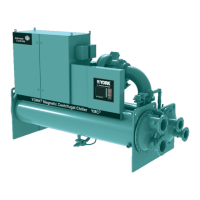JOHNSON CONTROLS
27
FORM 160.84-OM1
ISSUE DATE: 9/21/2017
3
SECTION 3 - OPTIVIEW™ CONTROL CENTER FUNCTIONS
AND NAVIGATION
INTERFACE CONVENTIONS
Each screen description in this document will begin
with a section entitled Overview which will describe
the graphical elements on the screen and give a short
summary of the functions available. Each element on
the screen will then be categorized into three distinct
groups: Display Only, Programmable, and Navigation.
Below is a short description of what types of informa-
tion are included in these groups.
The Programmable values and Navigation commands
are also subject to access level restrictions as described
below. For each of these elements, an indication is
given to show the minimum access level required to
program the value or navigate to the subscreen.
DISPLAY ONLY
Values in this group are read-only parameters of in-
formation about the chiller operation. This type of in-
formation may be represented by a numerical value, a
text string, or an LED image. For numerical values, if
the monitored parameter is above the normal operat-
ing range, the high limit value will be displayed along
with the ‘>’ symbol; if it is below the normal operating
range, the low limit value will be displayed along with
the ‘<’ symbol. In some cases, the value may be ren-
dered invalid by other conditions and the display will
use X’s to indicate this.
PROGRAMMABLE
Values in this group are available for change by the user.
In order to program any setpoints on the system, the user
must first be logged in with the appropriate access level.
Each of the programmable values requires a specific Ac-
cess Level which will be indicated beside the specified
value. All of the programmable controls in the system
fall into one of the categories described below:
Access Level
The OptiView™ Panel restricts certain operations
based on password entry by the operator. Three dif-
ferent access levels are provided as follows: VIEW:
The panel defaults to the lowest access level which
is termed VIEW. In this mode, the chiller operating
values and setpoints can be observed, but no changes
can be made. OPERATOR: The second access level
is termed OPERATOR and will allow the customer
to change all of the setpoints required to operate the
chiller system. In order to gain standard OPERATOR
level access, the Home Screen Login Password would
be entered as 9 6 7 5, using the numeric keypad. SER‑
VICE: In the event that advanced diagnostics are nec-
essary, a SERVICE access level has been provided.
Only qualified service personnel utilize this access lev-
el. This level provides advanced control over many of
the chiller functions and allows calibration of many of
the chiller controls. The access levels are listed above
in hierarchical order beginning with the lowest level
and proceeding to the highest level. Users logged in
under higher access levels may perform any actions
permitted by lower access levels.
The OPERATOR access level is accompanied by a
10-minute timeout. After ten (10) successive minutes
without a keypress, the panel will revert to the VIEW
access level. This prevents unauthorized changes to the
chiller if a user was logged in at a higher access level
and failed to logout. Proper procedure requires that
after making necessary setpoint adjustments the user
return to the Home Screen and logout.
Change Setpoints
On screens containing setpoints programmable at the
OPERATOR access level, a key with this label will be
visible if the present access level is VIEW. This key
brings up the Access Level prompt described above. It
allows the user to login at a higher Access Level with-
out returning to the Home Screen. After login, the user
may then modify setpoints on that screen.
Setpoints
The control center uses the setpoint values to control
the chiller and other devices connected to the chiller
system. Setpoints can fall into several categories. They
could be numeric values (such as 45.0°F for the Leav-
ing Chilled Liquid Temperature), or they could Enable
or Disable a feature or function.
Regardless of which setpoint is being programmed, the
following procedure applies:
1. Press the desired setpoint key. A dialog box ap-
pears displaying the present value, the upper and
lower limits of the programmable range, and the
default value.

